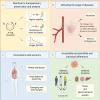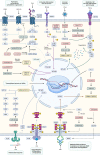Past, Present and Future: The Relationship Between Circular RNA and Immunity
- PMID: 35693804
- PMCID: PMC9174805
- DOI: 10.3389/fimmu.2022.894707
Past, Present and Future: The Relationship Between Circular RNA and Immunity
Abstract
The immune system has evolved since the birth of humans. However, immune-related diseases have not yet been overcome due to the lack of expected indicators and targeting specificity of current medical technology, subjecting patients to very uncomfortable physical and mental experiences and high medical costs. Therefore, the requirements for treatments with higher specificity and indicative ability are raised. Fortunately, the discovery of and continuous research investigating circular RNAs (circRNAs) represent a promising method among numerous methods. Although circRNAs wear regarded as metabolic wastes when discovered, as a type of noncoding RNA (ncRNA) with a ring structure and wide distribution range in the human body, circRNAs shine brilliantly in medical research by virtue of their special nature and structure-determined functions, such as high stability, wide distribution, high detection sensitivity, acceptable reproducibility and individual differences. Based on research investigating the role of circRNAs in immunity, we systematically discuss the hotspots of the roles of circRNAs in immune-related diseases, including expression profile analyses, potential biomarker research, ncRNA axis/network construction, impacts on phenotypes, therapeutic target seeking, maintenance of nucleic acid stability and protein binding research. In addition, we summarize the current situation of and problems associated with circRNAs in immune research, highlight the applications and prospects of circRNAs in the treatment of immune-related diseases, and provide new insight into future directions and new strategies for laboratory research and clinical applications.
Keywords: autoimmune diseases; circRNAs; immune-related diseases; immunity; infectious diseases; tumor.
Copyright © 2022 Gu, Su, Huang, Zhao and Li.
Conflict of interest statement
The authors declare that the research was conducted in the absence of any commercial or financial relationships that could be construed as a potential conflict of interest.
Figures



Similar articles
-
Circular RNAs in immune responses and immune diseases.Theranostics. 2019 Jan 1;9(2):588-607. doi: 10.7150/thno.29678. eCollection 2019. Theranostics. 2019. PMID: 30809295 Free PMC article. Review.
-
[Role of circular RNAs in immune-related diseases].Nan Fang Yi Ke Da Xue Xue Bao. 2022 Feb 20;42(2):163-170. doi: 10.12122/j.issn.1673-4254.2022.02.01. Nan Fang Yi Ke Da Xue Xue Bao. 2022. PMID: 35365439 Free PMC article. Review.
-
New Insight of Circular RNAs in Human Musculoskeletal Diseases.DNA Cell Biol. 2020 Nov;39(11):1938-1947. doi: 10.1089/dna.2020.5873. Epub 2020 Sep 29. DNA Cell Biol. 2020. PMID: 32991198 Review.
-
The Role of Circular RNAs in Immune-Related Diseases.Front Immunol. 2020 Apr 2;11:545. doi: 10.3389/fimmu.2020.00545. eCollection 2020. Front Immunol. 2020. PMID: 32300345 Free PMC article. Review.
-
circRNAs Signature as Potential Diagnostic and Prognostic Biomarker for Diabetes Mellitus and Related Cardiovascular Complications.Cells. 2020 Mar 9;9(3):659. doi: 10.3390/cells9030659. Cells. 2020. PMID: 32182790 Free PMC article. Review.
Cited by
-
circRNA/TLR interaction: key players in immune regulation and autoimmune diseases.Naunyn Schmiedebergs Arch Pharmacol. 2025 May 6. doi: 10.1007/s00210-025-04221-9. Online ahead of print. Naunyn Schmiedebergs Arch Pharmacol. 2025. PMID: 40328911 Review.
-
CircRnas in atherosclerosis, with special emphasis on the spongy effect of circRnas on miRnas.Cell Cycle. 2023 Mar;22(5):527-541. doi: 10.1080/15384101.2022.2133365. Epub 2022 Oct 13. Cell Cycle. 2023. PMID: 36229933 Free PMC article.
-
Circular RNAs in inflammatory bowel disease.Front Immunol. 2023 Dec 22;14:1307985. doi: 10.3389/fimmu.2023.1307985. eCollection 2023. Front Immunol. 2023. PMID: 38187401 Free PMC article. Review.
References
Publication types
MeSH terms
Substances
LinkOut - more resources
Full Text Sources
Medical
Miscellaneous

